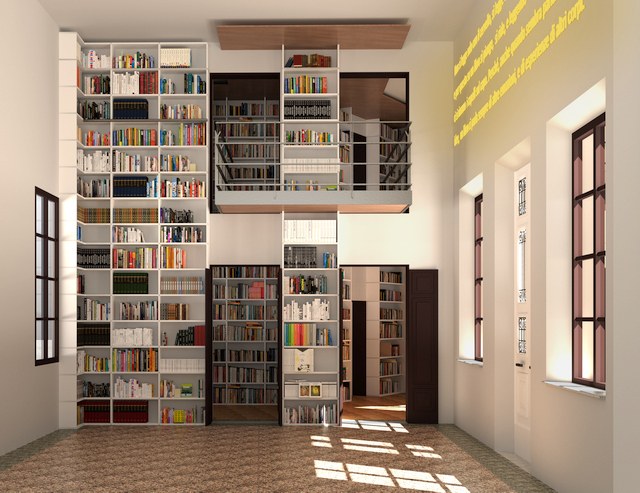Umberto Eco's library at Unibo
More than 40,000 books, notes and documents of Umberto Eco will find a new location in Bologna University Library (BUB). A space specifically designed to recreate the atmosphere of Eco's Modern Library will host the collection once belonged to this great mentor, semiologist and Unibo professor
The project for the space hosting the Modern Library of Umberto Eco has just been presented. This library comprehends more than 40,000 books, notes, and documents that once belonged to this great mentor, semiologist, and professor at the University of Bologna. This new space is in the 20th-century wing of Bologna University Library (BUB) that, with its independent access, looks over Piazza Puntoni.
Its white bookshelves on two levels separated by a walkaway are a clear reference to the original location of the books: Eco's flat in Milan with its tall, long and white bookshelves. This setting also speaks to the structure of the BUB, as it recalls the neoclassic shapes and the double heights of its great hall ("Aula Magna") commissioned by Benedetto XIV.
Reading rooms for studying and consulting books and qualified staff members will be available for all library users. Readers will be able to dive into Umberto Eco's books arranged in the same order they had in his home study in Milan. This space will allow exploring Eco’s line of thought physically and digitally.
The Modern Library counts approximately 44,000 books. It is composed of Eco's Milan library including copies of foreign books translated into Italian (approximately 33,000 books). Moreover, Eco brought 11,000 between books and magazines to his house in Monte Cerignone where he kept the books he did not need anymore. 5,000 of the 33,000 books from his home study library in Milan have inscriptions. Whereas his comments and notes are found in approximately 2,500 books.
The Archive of Documents consists of 300 folders containing Eco's correspondence from the 1950s onwards. There are also 100 folders containing (printed, typewritten, and handwritten) notes that, over the years, Eco had scattered across his residences.
The Ancient Book Collection. The "Bibliotheca Semiologica, Curiosa, Lunatica, Magica et Pneumatica” contains approximately 1,200 books, including incunabula, Aldine presses, and first editions that cover a time span that goes from the Middle Ages to the 20th century. This collection of books will be taken to Braidense National Library in Milan that is in charge of digitizing it.
ECO'S DIGITAL MODERN LIBRARY
This project consistently maps all the books in Umberto Eco's Modern Library. This mapping follows both the order and the classification made by the Professor in his personal library in Milan.
Eco's Modern Library is not only a physical archive, but it is also a repository of his conceptual and cultural mindset. Indeed, it represents the way he worked during his life: reading, studying and annotating books with many different aims, from academic and publishing scopes to other purposes like dissemination, teaching, and gamification.
Eco regarded books as work tools. Indeed, in his "How to write a dissertation" he wrote - and oftentimes repeated – books should never be left uncommented. Books need notes, underlining, and dog-ears to highlight and remember passages, pages, or chapters and making it easier to find your way back to the ideas and connections that those books inspired.
More specifically, the Digital Library will: highlight notes, underlining, dog-ears using mark-up systems that will become a tool for exploring the methodologies of Eco's work; clarify and highlight the connections that Eco suggested and often rewrote: in this way, a network of indexed dynamic connections will be available thanks to the Linked Open Data; inspire readers to build new paths of analysis thanks to innovative systems of information visualization; create multimedia games to be played online: from treasure hunts to Eco's beloved crosswords puzzles.
Access to the Digital Library will also be made possible through an app allowing for 3D browsing of both the physical (the shelves) and the semantic (the network of concepts that emerges from the location of the books) organization of the library - two aspects that live and intertwine within the library itself.
This project intends to provide users with an interactive and dynamic experience of Eco's Modern Library, thus assuring that its fundamental character of a mutable living being, as imagined by the Professor, will be maintained.
Eco's Modern Library intends to speak to three main audiences: students: by exploring the Digital Library, boys and girls will learn a new way of reading and studying through an innovative, interactive, and entertaining method; inquisitive minds: the Index Humbertinus is a contextual and lexis-based search engine that allows looking up quotes, the context of the use of some words and how Eco used some texts; scholars and academics: besides the Index Humbertinus, starting from his notes, the project draws attention to intertextual relationships between texts written by Eco himself (essays, novels, and editorials) and between them and other authors whom he quoted. Finally, this project will also develop several tools for studying the creative process that originated Eco's works and that the book arrangement in his Modern Library crucially mirrored.


